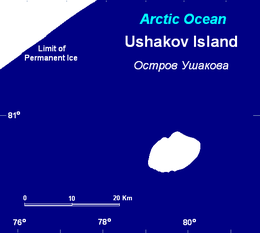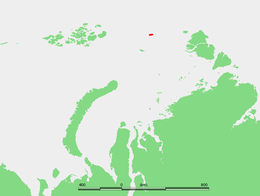Ushakov Island
| Russian: Остров Ушакова | |
|---|---|

Ushakov island is practically covered with ice and snow the whole year round
|
|
 |
|
| Geography | |
| Location | Arctic Ocean |
| Coordinates | 80°48′N 79°29′E / 80.800°N 79.483°ECoordinates: 80°48′N 79°29′E / 80.800°N 79.483°E |
| Area | 324 km2 (125 sq mi) |
| Length | 25.5 km (15.84 mi) |
| Width | 17.5 km (10.87 mi) |
| Highest elevation | 294 m (965 ft) |
| Highest point | Ice cap HP |
| Administration | |
| Demographics | |
| Population | 0 |
Ushakov Island (Russian: Остров Ушакова, Ostrov Ushakova) is an isolated island located in the Arctic Ocean, Russian Federation.
The average yearly precipitation ranges from 200 millimetres (8 inches) at a height of 50 metres (164 feet) and between 350 millimetres (14 inches) and 400 millimetres (16 inches) around the highest point of the island's ice cap.
Ushakov Island is located close to the region of permanent sea ice midway between Franz Josef Land and Severnaya Zemlya, at the northern limit of the Kara Sea. This island lies close to the limit of permanent ice; it is desolate and subject to severe Arctic storms. Its total area is 324 square kilometres (125 square miles). This island belongs to the Taymyrsky Dolgano-Nenetsky District of the Krasnoyarsk Krai administrative division of Russia. Owing to its extreme northerly location, the sea surrounding Ushakov Island is covered with pack ice in the winter and is full of ice floes during the summer. The closest land is lonely Vize Island 140 kilometres (87 miles) further south.
Ushakov Island is covered by an ice cap. The highest point of the ice cap is 294 m (965 ft). The rocky ground below the icemass is flat and part of it lies below sea level. The edges of the ice cap form 20 m (66 ft) to 30 m (98 ft) high icy cliffs along the shore. The surface of the ice cap has become 2 square kilometres (1 square mile) smaller between 1950 and 2000, but the ice volume has grown from 35 cubic kilometres (8 cubic miles) to 38 cubic kilometres (9 cubic miles). The average thickness of the ice having increased from 107 m (351 ft) to 118 m (387 ft).
This island was the last piece of undiscovered territory in the Soviet Arctic. It was finally located in 1935 when the few remaining unexplored areas in the northern Kara Sea were surveyed by Soviet hydrographic and oceanographic operations on icebreakers to study the sea and ice.
...
Wikipedia
